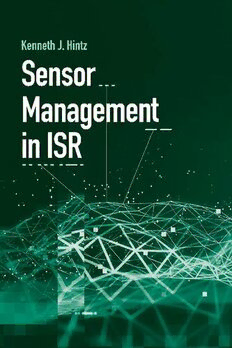Table Of ContentSensor Management in ISR
For a complete listing of titles in the
Artech House Intelligence and Information Operations Series,
turn to the back of this book.
Sensor Management in ISR
Kenneth J. Hintz
Library of Congress Cataloging-in-Publication Data
A catalog record for this book is available from the U.S. Library of Congress.
British Library Cataloguing in Publication Data
A catalogue record for this book is available from the British Library.
Cover design by John Gomes
ISBN 13: 978-1-63081-685-8
© 2020 ARTECH HOUSE
685 Canton Street
Norwood, MA 02062
All rights reserved. Printed and bound in the United States of America. No part of this book
may be reproduced or utilized in any form or by any means, electronic or mechanical, including
photocopying, recording, or by any information storage and retrieval system, without permission
in writing from the publisher.
All terms mentioned in this book that are known to be trademarks or service marks have been
appropriately capitalized. Artech House cannot attest to the accuracy of this information. Use of
a term in this book should not be regarded as affecting the validity of any trademark or service
mark.
10 9 8 7 6 5 4 3 2 1
Contents
Preface xiii
1 Introduction to Sensor Management 1
1.1 Motivation for Sensor Management in Intelligence,
Surveillence, and Reconaissance 1
1.2 Sensor Management versus Data Fusion 4
1.3 Sensor Management Is Motivated by the Need to
Inform Situation Assessment 8
1.4 Sensor Management 10
1.5 Sensor Scheduling, Sensor Management, and Mission
Management 12
1.6 Optimum Planning versus Optimum Scheduling 13
1.7 Sensor Suite Viewed as a Constrained Communications
Channel 14
1.8 Preliminaries 15
1.9 Road Map for the Sequel 17
References 18
v
vi Sensor Management in ISR Contents vii
2 Historical Basis for Sensor Management 21
2.1 From Task-Specific Sensor to Heterogeneous Network 21
2.2 Integration of Frequency Diverse Radars 25
2.3 Integration of Modality Diverse Sensors During the
Vietnam Era 25
2.4 Networks of Homogeneous Sensors 26
2.5 Network of Heterogeneous Sensors 28
2.6 Network-Centric Warfare: The Start of Modern
Sensor Management 29
References 33
3 Sensor Management Inherent Problems 35
3.1 Indirect Sensor Management Issues 35
3.2 Multidisciplinary Problem 36
3.3 Passive Sensor Issues 38
3.4 Active Sensor Issues 39
3.5 Virtual Sensor, Heterogeneous Sensor, and
Pseudo-Sensor Issues 39
3.6 World Models 40
3.6.1 Physical Models 41
3.6.2 Context 42
3.6.3 Probabilistic Models 43
3.6.4 Social Network Models 46
3.7 Operational Issues 46
3.7.1 Myopic Scheduling 46
3.7.2 Sensor Management Objective Functions 48
References 50
4 Sensor Management Related Problems 55
4.1 Introduction 55
vi Sensor Management in ISR Contents vii
4.2 Fusion-Related Issues 55
4.2.1 Common Frame of Reference and Merging of Data
from Different Platforms 56
4.2.2 Data Association Coordinate System Errors 57
4.2.3 Data Pedigree 57
4.2.4 Data Veracity 58
4.2.5 Hard and Soft Data Fusion 58
4.3 Alternative Configurations for Search, Track, and
Identification 59
4.4 Detection Criteria 60
4.5 Target Models 61
4.6 Scheduling Constraints 62
4.6.1 Deleterious Interaction of Sensors 63
4.6.2 Computational Constraints 64
4.6.3 Randomly Occurring Sensor Failures 65
References 65
5 Theoretical Approaches to Sensor Management 69
5.1 Overview of Sensor Management Theories 69
5.2 Scheduling Approaches versus Decision-Making
Approaches 71
5.3 Decision Theoretic Approaches 74
5.4 Normative Decision Theoretic Approaches 75
5.5 Descriptive Decision Theoretic Approaches 79
5.6 Sensor Management Architecture-Based Approaches 81
5.6.1 Decentralized Management 82
5.6.2 Game Theory-Based Approaches 83
5.6.3 Market Theory-Based Approaches 83
5.6.4 Hybrid Approaches 85
References 88
6 Artificial Intelligence for Sensor Management 91
6.1 Introduction 91
viii Sensor Management in ISR Contents ix
6.2 Resurgence of AI 92
6.3 Specific Mapping of AI Capabilities to IBSM Functions 93
6.4 Supervised Machine Learning 93
6.5 Unsupervised Machine Learning 94
6.6 Data Fusion 95
6.6.1 Implementing Data Fusion Within IBSM 95
6.7 Ontologies for Storage and Reasoning 96
6.8 Characterizing Uncertainty 97
6.9 Qualitative Reasoning 99
6.10 Distributed Cognition for Sensor Management 99
6.11 Levels of Autonomy 100
6.11.1 A Survey of Levels of Autonomy 100
6.11.2 Adaptability Enables Autonomy 101
6.11.3 Measuring Adaptability 101
6.11.4 Foreseeable Adaptation 103
6.11.5 Unforeseeable Adaptation 103
6.11.6 Adaptation Measurement 104
6.12 Measuring the Effectiveness of Autonomy 104
6.13 Control Models for Close Coordination of Sensor
Platforms 105
6.14 Machine Learning 106
6.15 Explainable AI 107
References 108
7 MQ-4C Triton: A Case Study 113
7.1 Overview of the Triton Broad Area Maritime
Surveillance System 113
7.2 A Brief History of Triton 116
7.3 The Triton Sensor Payload 117
viii Sensor Management in ISR Contents ix
7.4 Operational Management of Triton 119
7.5 Doctrinal Guidance for Triton Operation 120
7.6 Sensor Management During a Notional Triton Sortie 121
References 124
8 Information Theoretic Approach to Sensor
Management 127
8.1 Overview of the IBSM 127
8.2 Data, Information, and Knowledge 130
8.3 Information Measures 134
8.3.1 Fisher Information 135
8.3.2 Kullback- Leibler Divergence 135
8.3.3 Mutual Information 136
8.3.4 Csiszar-Rényi Generalized Information 136
8.3.5 Entropy 136
8.3.6 Knowledge 137
8.3.7 NIIRS Information 141
8.3.8 IBSM Information Measures 142
8.3.9 Sensor Information 142
8.3.10 Situation Information 145
8.4 Time Value of Information (TVI) 146
8.5 The IBSM Model 147
8.6 Collaboration among IBSM-Managed Sensor Platforms 150
8.7 Benefits of the IBSM 151
8.8 Summary 153
References 153
9 IBSM Optimization Criterion: Expected Information
Value Rate 157
9.1 Global, Commensurate, Objective Function 157
9.1.1 EIVR Expected Situation Information Value Rate 159
sit
9.1.2 EIVR Expected Sensor Information Value Rate 160
sen
9.2 BNCO 161

